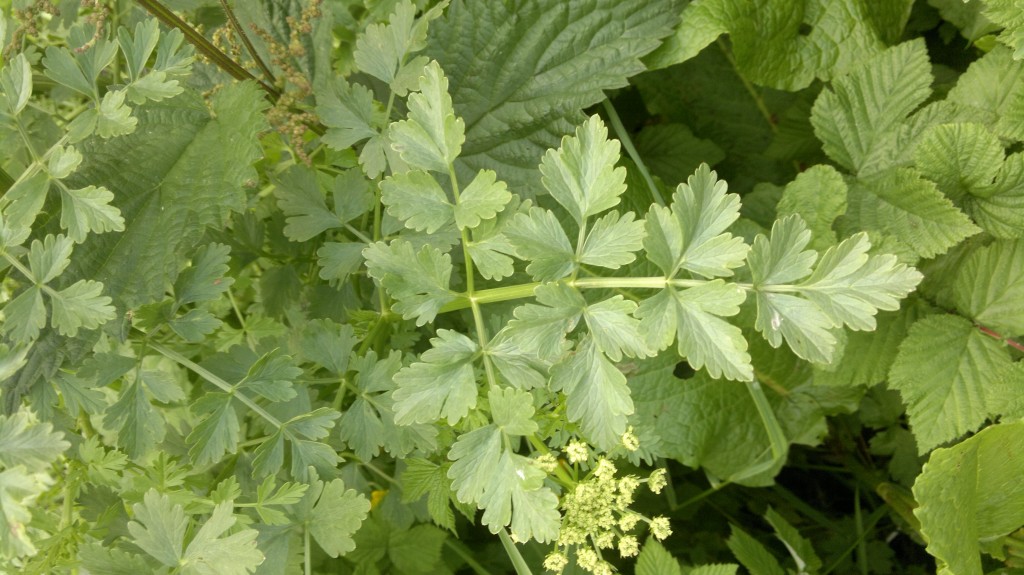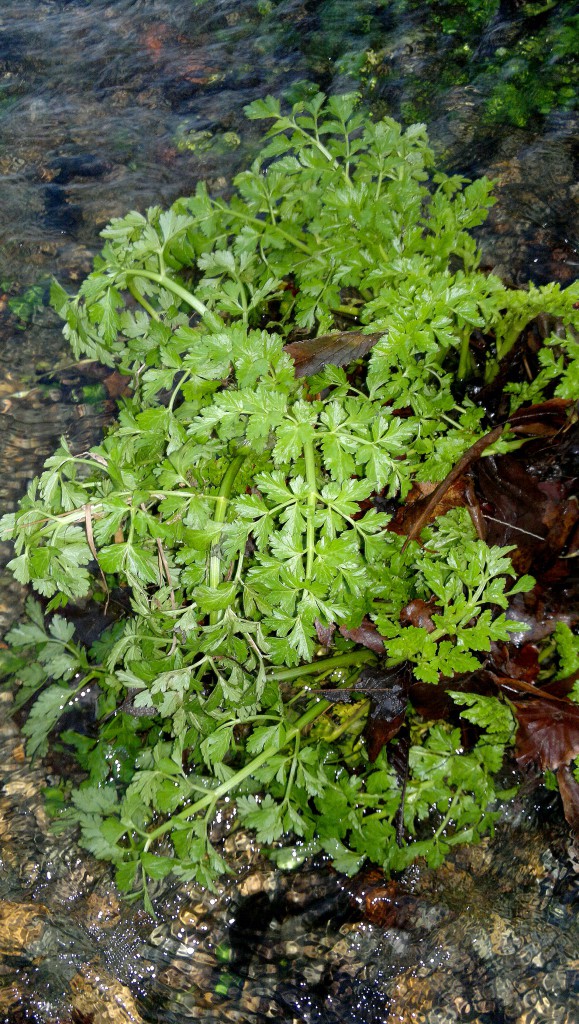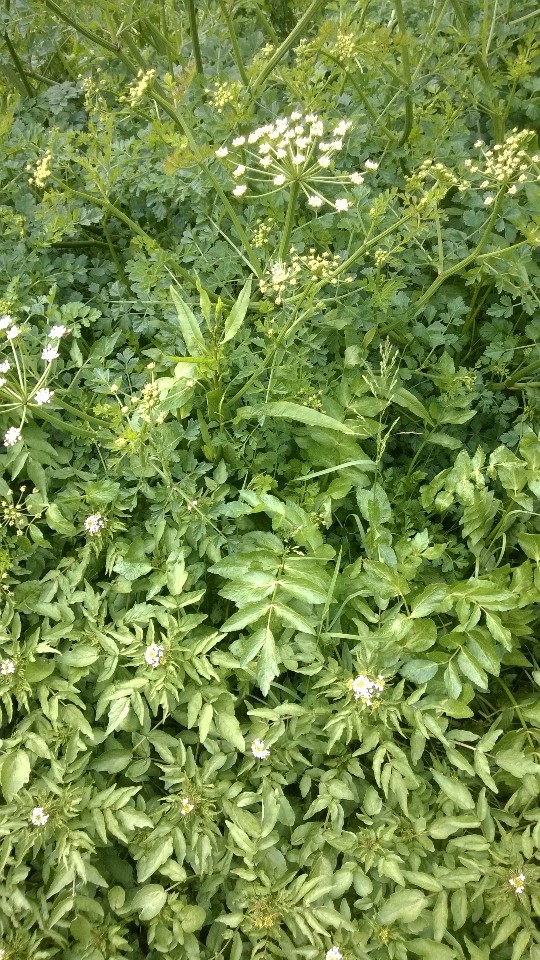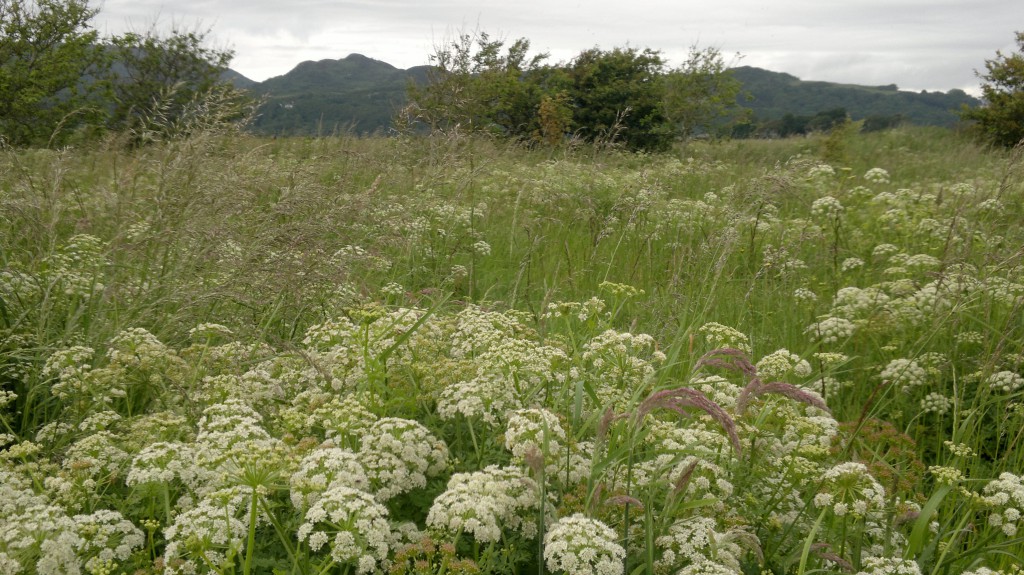Poisonous plants – hemlock water-dropwort
Oenanthe crocata
Hemlock water-dropwort (not to be confused with its equally toxic cousin hemlock (Conium maculatum) is common in shallow water and wet ground throughout the UK, especially ditches, slow-flowing streams and on foreshores. It has been mistaken for wild celery or water-parsnip – be very careful when IDing either of these for eating, or indeed any member of the carrot family. All parts of hemlock water-dropwort are potentially deadly. Look out for distinctive carrot family leaves (3-4 times pinate at base) growing from or near water, strong unpleasant smell when broken (like acrid celery), hairless hollow grooved stem and white swollen roots.
Both foragers and dog walkers should familiarise themselves with the distinctive “dead man’s fingers” of hemlock water-dropwort roots. These are often exposed on river banks or washed up after floods or high tides. Most years they result in the deaths of several dogs around the UK after winter storms.
Regardless of its toxicity, I am very fond of hemlock water-dropwort. Its growth is remarkably vibrant from December through to June. In dark winter months where not much is growing, it is easy to spot by its vigorous green growth in damp spots – often growing directly from water.
Winter is a good time to “tune in” to it, before it gets mixed up with other plants. Be particularly careful if harvesting watercress or pie cress in the spring – they are regularly entwined with HWD.
In the spring and summer, its rounded umbels of small white flowers are a rich source of food for hoverflies and other insects, and wetlands can look spectacular festooned in their white baubels.
HWD has a fascinating history. Its very toxicity once held it in high esteem when capital punishment and euthanasia were more common, and easy methods of execution valued. A “sardonic” smile, is a direct reference to the widespread use of HWD in Sardinia where a decoction of its roots were used to administer death sentences. As this powerful muscular convulsant stopped the victims heart, it would also act on facial muscles, drawing the face into a grim “Sardinian”, or sardonic, smile.
Related articles:






14 Comments
Awesome and informative. Love your photos too! Thanks. You are awesome.
Thanks April!
thanks graeme, I just sent you an email.
Mark
The sardonic smile – this is one of my favourite EVER facts – brilliant , THANKYOU … And also for confirming my identification of this amazing plant
Very informative article, did not realises how dangerous this plant was. Will point it out now to my grandchildren.
Never knew this, thank you for such an informative website. One mammoth question. Since I live in Italy, is there a possibility of adding a distribution map of the species you consider? I have a butterfly and bird app. very useful in this respect, well worth the price of an app.
Thanks again, CCL
Thanks, glad you find it useful. 🙂
There is a serious limit to how wide I can cast my net – and how much time I can apply to this, free of charge!
Great article Mark, Thanks Loads of HWD on the site im working at.
Just found this in fact-checking an episode of “Midsomer Murders”!
Thank you. We have a lot of this growing on our land. Could you tell me the risks on plant to skin contact?
I am not aware of any issues with HWD in terms of asking contact, in so far as the toxins do have to be ingested to take effect, and are not absorbed through the skin through normal sensible handling. However, HWD is closely related to celery, parsnip and common hogweed – all of which can cause phytophotodermititus on contact with the skin, depending on state/part of plant, person handling, sunlight etc. See my detailed discussion of this on my page on common hogweed. https://gallowaywildfoods.com/hogweed/
Hey Mark,
Thanks for yet another brilliant post and photos on this one.
Having just gathered a lot of washed up seaweed in November I’ve now been alerted to local sightings around the same time. It featured in the Sun, Mail, NewsandStar etc
I now have to decide if it’s safe to use said seaweed on the garden.
Has there been any unusual prevalence locally in the last few months?
I guess difficult to judge if and how long it will take to break down in soil or compost?
I’m guessing that any plantlets that have survived will still have the classic root form and hence should be readily identifiable?
The only other worry then would be seed propagation.
Cheers, George
Hi George,
I’m no gardener (as you know!), but can’t think how any bits of HWD would cause a problem if its in your seaweed for your garden. I expect it will just break down like compost and add something good. Any viable roots would only really succeed in very wet ground, and i’m sure you could weed them out if they worried you – though they are great food for pollinating insects.
Cheers, Mark.
This article was really informative and interesting. Everything is well explained and the site has a good design too!
Thank you for all the information.